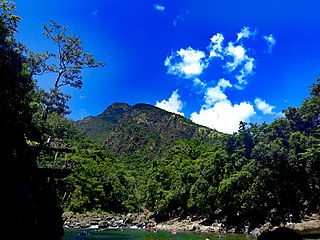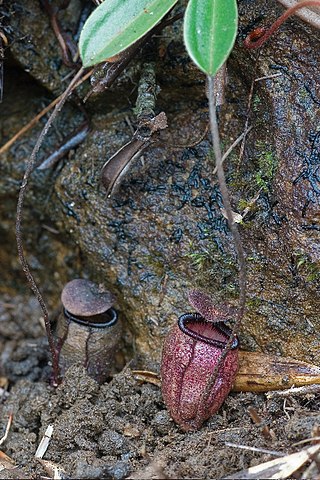
Romblon, officially the Province of Romblon, is an archipelagic province of the Philippines located in the Mimaropa region. Its main components include Romblon, Romblon, an archipelagic municipality of the same name that also serves as the provincial capital; Tablas, the largest island, covering nine municipalities; Sibuyan with its three towns; as well as the smaller island municipalities of Corcuera, Banton, Concepcion, San Jose. The province lies south of Marinduque and Quezon, east of Oriental Mindoro, north of Aklan and Capiz, and west of Masbate. According to the 2020 census, it has a total population of 308,985.

Mindoro is the seventh largest and eighth-most populous island in the Philippines. With a total land area of 10,571 km2 and has a population of 1,408,454 as of 2020 census. It is located off the southwestern coast of Luzon and northeast of Palawan. Mindoro is divided into two provinces: Occidental Mindoro and Oriental Mindoro. San Jose is the largest settlement on the island with a total population of 143,430 inhabitants as of 2015. The southern coast of Mindoro forms the northeastern extremum of the Sulu Sea. Mount Halcon is the highest point on the island, standing at 8,484 feet (2,586 m) above sea level located in Oriental Mindoro. Mount Baco is the island's second highest mountain with an elevation of 8,163 feet (2,488 m), located in the province of Occidental Mindoro.

Surat Buhid is an abugida used to write the Buhid language. As a Brahmic script indigenous to the Philippines, it closely related to Baybayin and Hanunó'o. It is still used today by the Mangyans, found mainly on island of Mindoro, to write their language, Buhid, together with the Filipino latin script.

Sibuyan is a crescent-shaped island, the second largest in an archipelago comprising Romblon Province, Philippines. Located in the namesake Sibuyan Sea, it has an area of 445 square kilometres (172 sq mi) and has a total population of 62,815 as of 2020 census. The island has two prominent peaks, the highest is Mount Guiting-Guiting with an elevation of 2,058 metres (6,752 ft) and Mount Nailog with a height of 789 metres (2,589 ft). The people speak the Sibuyanon dialect of Romblomanon, a Visayan language.

Mount Guiting-Guiting is the highest mountain in the province of Romblon, located in Sibuyan Island, in the Philippines, with an elevation of 6,752 ft (2,058 m) above sea level. Its steep slopes and jagged peak, have earned it a reputation as one of the most difficult and technically most challenging mountains to climb in the Philippines. It is ranked as the 11th-most prominent mountain in the Philippines, and 71st-highest peak of an island in the world. Located at the heart of Sibuyan, it dominates the landscape for miles around. Guiting-Guiting, in the Romblomanon dialect means "jagged". It is one of the focal points of Sibuyan's declaration as a biodiversity haven and has been dubbed by some local and international natural scientists as The Galapagos of Asia. The island of Sibuyan has been compared numerous times with the biodiversity endemism rate of the Galapagos islands in Ecuador. This high endemism prompted much of the mountain and its slopes to be protected in 1996 as the Mt. Guiting-Guiting Natural Park. The park also encompasses nearby Mt. Nailog to the west.
Ratagnon is a regional language spoken by the Ratagnon people, an indigenous group from Occidental Mindoro. It is a part of the Bisayan language family and is closely related to other Philippine languages. Its speakers are shifting to Tagalog. In 2000, there were only two to five speakers of the language. However, in 2010 Ethnologue had reported there were 310 new speakers.
Ratagnon is one of the eight indigenous groups of Mangyan in the southernmost tip of Occidental Mindoro and the Mindoro Islands along the Sulu Sea. The Ratagnon live in the southernmost part of the municipality of Magsaysay in Occidental Mindoro. Their language is similar to the Visayan Cuyunon language, spoken by the inhabitants of Cuyo Island in Northern Palawan.

Mangyan is the generic name for the eight indigenous groups found on the island of Mindoro, southwest of the island of Luzon, the Philippines, each with its own tribal name, language, and customs. The total population may be around 280,001, but official statistics are difficult to determine under the conditions of remote areas, reclusive tribal groups and some having little if any outside world contact.

San Fernando, officially the Municipality of San Fernando, is a 4th class municipality in the province of Romblon, Philippines. According to the 2020 census, it has a population of 24,171 people.

Cajidiocan, officially the Municipality of Cajidiocan, is a 4th class municipality in the province of Romblon, Philippines. According to the 2020 census, it has a population of 23,259 people. The municipality is located on Sibuyan Island, which has been dubbed as the "Galapagos of Asia" due to its pristine natural environment and high endemism rate for flora and fauna.

Magdiwang, officially the Municipality of Magdiwang, is a 5th class municipality in the province of Romblon, Philippines. According to the 2020 census, it has a population of 15,385 people.

Nepenthes sibuyanensis is a tropical pitcher plant endemic to Sibuyan Island in the Philippines, after which it is named.

Nepenthes argentii is a highland Nepenthes pitcher plant native to Mount Guiting-Guiting on Sibuyan Island in the Philippines. It is possibly the smallest species in the genus and does not appear to have a climbing stage.
Sibuyanons Against Mining (SAM) is an environmental advocacy group organized primarily by Sibuyanons. It has been fighting for mining moratorium in Sibuyan Island (Philippines). It aims to protect the island, which has the world's densest forest, the Philippine's cleanest river and Mount Guiting-Guiting, from future environmental degradation and exploitation.
The Southern Mindoro languages are one of two small clusters of Austronesian languages spoken by the Mangyan people of Mindoro Island in the Philippines. They make up a branch of the Greater Central Philippine subgroup.

The National Commission on Indigenous Peoples (NCIP) is the agency of the national government of the Philippines that is responsible for protecting the rights of the indigenous peoples of the Philippines. The commission is composed of seven commissioners. It is attached to the Department of Social Welfare and Development.

Rodne Rodiño Galicha is a Filipino environmentalist and human rights activist currently involved in climate justice, biodiversity conservation and natural resources conflict management. He is the author of a pocket-sized book on emerging environment issues: We Are Nature. On 5 December 2013, he received the 2013 Hero for the Environment national individual award from the Center for Environmental Concerns in collaboration with the Department of Environment and Natural Resources of the Republic of the Philippines. He was Philippine Manager for The Climate Reality Project and currently doing his voluntary work for ecological and cultural organization called Bayay Sibuyanon in his home-island of Sibuyan. In 2018, the Philippine Tatler included him in the Generation T list as one of the 50 brightest connectors, creative visionaries, influential innovators and disruptive talents in the Philippines. He is also one of the recipients of the 2018 The Outstanding Young Men (TOYM) of the Philippines. Stepping-up climate and environmental action, he heads Living Laudato Si movement in the Philippines; and national convener of Aksyon Klima Pilipinas. He co-founded OeconoMedia, a faith-based news platform that produces and distributes original reporting about the environment, the climate crisis, and the global Laudato si' campaign of the Catholic Church.
The Romblon boobook or Romblon hawk-owl, is a species of owl in the family Strigidae that is endemic to the Philippines. It is only found on the islands of Tablas, Sibuyan and Romblon. It was previously known as a subspecies of the Philippine hawk-owl, but was reclassified in 2012, as voice and other evidence suggested it was a distinct species. Its natural habitat is tropical moist lowland forest. It is threatened by habitat loss.

Nepenthes erucoides is an ultramaficolous tropical pitcher plant endemic to Mount Redondo, the highest peak on the Philippine island of Dinagat, where it occurs from c. 800 meters up until the summit at 929 meters. It grows on a very thin substrate consisting of "lateritic nickel ore and decomposed chromite rubble, through to a clay derived thereof", which has been described as the most extreme ultramafic substrate known to host Nepenthes. Its taxonomic affinities are unclear, though it has been noted for its similarities to N. mantalingajanensis from Palawan. The species' ultramaficolous ecological setting has permitted the radiation of a peculiar set of associated traits, those being: "reduced leaf morphologies, sclerophyllous characteristics, hirsuteness and small stature", which have been associated similarly with the diminutive Nepenthes argentii of the windswept, ultramafic peak of Mount Guiting-Guiting, Sibuyan. The authors suggest that morphological analogues in the aforementioned species do not entail genetic association, and as such these may be considered as instances of morphological convergence- derived from associated conditions in ultramaficolous ecology- until further genetic analysis occurs. Nepenthes erucoides co-localizes with N. mindanaoensis and N. bellii. Nepenthes truncata occurs within the extent of the elfin forest below the 800 meter elevation band, N. merrilliana occurring regionally at elevations below 600 meters.

The Greater Negros–Panay rain forests ecoregion covers the central Visayan Islands in the Philippines, including the islands of Panay, Negros, Cebu, Masbate, Sibuyan, Ticao, Guimaras, Romblon, Tablas, Siquijor, and Bohol, but excludes Leyte and Samar. During the last ice age, these were all on the same island. The lack of a land bridge to Asia during the ice age kept most Asian megafauna, including elephants and tigers, from reaching the Philippines and the Visayan Islands, which hosts many unique and endemic species with some exclusive only to an island.














